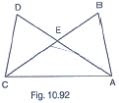Chapter 10 Congruent Triangles RD Sharma Solutions Exercise 10.4 Class 9 Maths

Chapter Name | RD Sharma Chapter 10 Congruent Triangles Exercise 10.4 |
Book Name | RD Sharma Mathematics for Class 10 |
Other Exercises |
|
Related Study | NCERT Solutions for Class 10 Maths |
Exercise 10.4 Solutions
1. In Fig. 10.92, it is given that AB = CD and AD = BC. Prove that ΔADC ≅ ΔCBA.

Solution

Given that in the figure AB = CD and AD = BC.
We have to prove
ΔADC ≅ ΔCBA
Now,
Now,
Consider ΔADC and ΔCBA,
We have
AB = CD [Given]
BC = AD [Given]
And AC = AC [Common side]
BC = AD [Given]
And AC = AC [Common side]
So, by SSS congruence criterion, we have
ΔADC ≅ ΔCBA
∴ Hence proved
2. In a ΔPQR, if PQ = QR and L, M and N are the mid - points of the sides PQ, QR and RP respectively. Prove that LN = MN.
Solution

Given that in ΔPQR, PQ = QR and L, M and N are mid - points of PQ, QR and RP respectively
We have to prove LN = MN.
Join L and M, M and N, N and L
We have
PL = LQ, QM = MR and RN = NP
[∵ L, M and N are mid - points of PQ, QR and RP respectively]
And also,
PQ = QR ⇒ PL = LQ = QM = MR = PQ/2 = QR/2 ...(1)
Using mid - point theorem, we have
MN || PQ and MN = (1/2)(PQ)
⇒ [MN = PL = LQ] ...(2)
Similarly, we have
LN || QR and LN = (1/2)(QR)
⇒ LN = QM = MR
From equation (1), (2) and (3), we have
PL = LQ = QM = MR = MN = LN
∴ LN = MN
